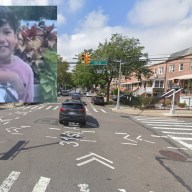By Rebecca Henely
In the midst of widespread infectious disease, New York City implemented numerous design changes more than 100 years ago that drastically improved its residents’ wellbeing.
Now the city hopes to do the same for obesity.
“Relatively minor significant changes in people’s activity can create significant differences in their health,” said Suzanne Nienaber, active design training coordinator for the city Department of Health and Mental Hygiene.
Nienaber, along with other officials from the city Department of Education, laid out the city Department of Design and Construction’s principles in creating a more “fit city” during a lecture held May 16 at LaGuardia Community College, at 31-10 Thomson Ave. in Long Island City.
Nienaber said the city should promote transportation that requires people to be active, recreation that encourages children and adults to move around, building designs that encourage workers and residents to move through them in active ways and easy access to good nutrition in all neighborhoods.
In 1840s New York City, numerous deaths were attributed to infectious illnesses such as tuberculosis, cholera and yellow fever, Nienaber said. Throughout the next 100 years, the city made a number of changes, such as creating a system to bring fresh water from upstate, building Central Park, opening the Department of Sanitation and constructing the subways.
Now 75 percent of Americans die from chronic disease, and some of those illnesses, like diabetes and heart disease, are partly attributable to obesity. Statistics from the Health Department say that 34 percent of adult New Yorkers are overweight and 22 percent are obese.
Meanwhile, one in five kindergarten students in New York City is considered obese. In 2010 the city had singled out Corona as having the highest levels of child obesity in the five boroughs.
Roger Platt, director of school health for the city, said obesity is a worldwide problem that can be mitigated with exercise and a more active lifestyle.
“Physical activity is the magic treatment for a lot of things,” Platt said.
Nienaber said the city is trying to encourage physical activity through its “Active Design Guidelines.” These principles encourage the use of bicycles and recommend the construction of bike lanes or indoor racks to make bicycling as a mode of transport more attractive and less subject to thefts.
But they can also be as simple as installing a staircase in a new building in an open, beautiful space to make it more attractive. Playgrounds will also be more used if more amenities for adults are installed or the playground is decorated more colorfully.
“Something as simple as painting on the ground will make children play more actively,” Nienaber said.
She said better nutrition for kids can be achieved with more access to tap water, either through drinking fountains or fountains to fill up water bottles. Community gardens can also be a fun way to keep kids healthy. It makes good food and keeps them outside.
“We know that gardening is a great physical activity,” Nienaber said.
The Active Design Guidelines can be downloaded at nyc.gov/adg.
Reach reporter Rebecca Henely by e-mail at rhenely@cnglocal.com or by phone at 718-260-4564.


































